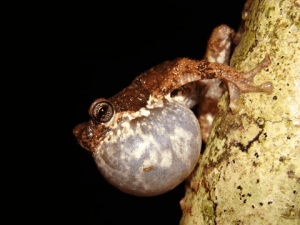TAG: GS 3: ECOLOGY AND ENVIRONMENT
THE CONTEXT: Climate change poses a severe threat to the Malabar Tree Toad (MTT), an endemic species to India’s Western Ghats.
EXPLANATION:
- This unique arboreal amphibian, unlike most ground-dwelling toads, faces a significant reduction in its distribution range due to changing environmental conditions.
- Recent studies highlight a potential decline in the toad’s population by up to 68.7% by the end of this century, emphasizing the urgent need for conservation efforts.
The Malabar Tree Toad
- The Malabar Tree Toad is the only species in the monotypic genus Pedostibes.
- It is exclusively found in the Western Ghats, a biodiversity hotspot known for its rich variety of flora and fauna.
- Unlike other toads in the region that reside on the ground, the Malabar Tree Toad has evolved to climb and live in trees, showcasing its distinctive ecological niche.
- It was discovered in 1876.
- The species remained unseen for over a century until it was rediscovered in 1980 at Silent Valley National Park in Kerala.
- Since then, sightings have been sporadic, with increased observation only beginning around 2014.

Climate Change Impact on Species Distribution
- According to the study, climate change could drastically reduce the distribution of the Malabar Tree Toad in India’s protected areas (PAs).
- The research, involving both citizens and scientists, predicts that by 2061-2080, the species’ range could shrink by 68.7% under high-emission scenarios.
- The study used multiple models to assess future climate scenarios, including high and low emissions.
- Under low-emission scenarios, however, the toad’s distribution might increase by as much as 111.3%, though this is less likely given current global emission trends.
Conservation Status and Challenges
- The Western Ghats region, where the MTT is found, is home to 252 amphibian species, many of which are already facing severe threats.
- Seventeen species are critically endangered, and 40 others are classified as ‘data deficient,’ highlighting the precarious status of amphibians in this region.
- Globally, amphibians are the most threatened group of vertebrates, with 40.7% of species at risk due to various anthropogenic factors such as habitat fragmentation, pollution, diseases, and now climate change.
- These factors have led to a steady decline in amphibian populations over the past four decades.
Methodology and Findings of the Study
- The study, published in the journal Nature, is groundbreaking in its use of citizen science to model the distribution of an endangered amphibian species.
- The authors utilized 655 observations of the Malabar Tree Toad from citizen science platforms, as well as data from scientific literature dating back to 1876.
- These observations were analyzed to understand the species’ current and future distribution under different climate scenarios.
- The research found that PAs in the central Western Ghats are likely to lose much of their biodiversity due to climate change, while habitats in the southern Western Ghats may become more suitable for the MTT.
- Specific wildlife sanctuaries, such as Mhadei, Mookambika, Sharavathi Valley, and Netravali, could see an increase in MTT populations, whereas others, like Kalakad Mundanthurai Tiger Reserve and Brahmagiri Wildlife Sanctuary, may witness a decline in suitable habitats.
The Role of Habitat and Microclimates
- The study highlights that the future distribution of the Malabar Tree Toad will primarily occur in evergreen forests (63.6%), with smaller pockets in plantations, croplands, and mixed forests.
- The species also appears in human-modified habitats, indicating its adaptability to some extent.
- However, it remains dependent on specific microhabitats, particularly during the breeding season when it descends from the trees to breed in water pools formed at the edges of streams during the monsoon.
- The availability of such microhabitats is crucial for the species’ survival.
Conservation Implications and Future Steps
- The study underscores the need for enhanced surveys of Malabar Tree Toad habitats within and outside PAs in the Western Ghats to ensure the species’ survival.
- The study is a pioneering effort in using distribution modeling for amphibians in India.
- A biodiversity expert adds that amphibians are particularly vulnerable to climate change due to their specific habitat needs and limited dispersal abilities, making such research vital for conservation planning.
Citizen Science and Government Action
- The use of citizen science in this study has proven invaluable in gathering data on the Malabar Tree Toad, a species that has remained elusive for over a century.
- The importance of such initiatives in enhancing our understanding of species distribution and the impacts of climate change has been emphasized.
- Given the findings, a proposal has been submitted to the Government of Karnataka to declare the Malabar Tree Toad as the state amphibian, which could help in garnering more attention and resources for its conservation.




